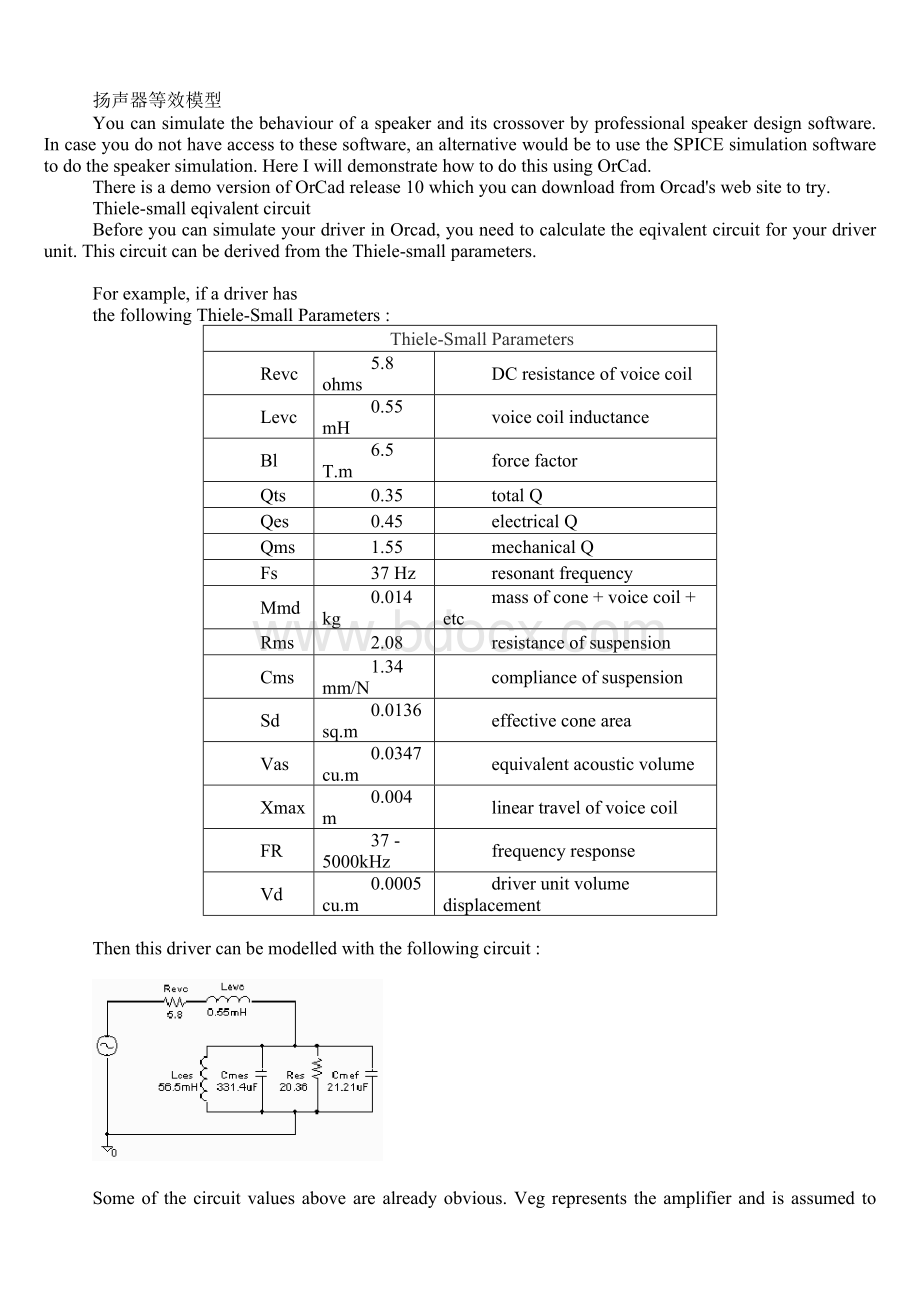扬声器等效模型.doc
《扬声器等效模型.doc》由会员分享,可在线阅读,更多相关《扬声器等效模型.doc(10页珍藏版)》请在冰豆网上搜索。

扬声器等效模型
Youcansimulatethebehaviourofaspeakeranditscrossoverbyprofessionalspeakerdesignsoftware.Incaseyoudonothaveaccesstothesesoftware,analternativewouldbetousetheSPICEsimulationsoftwaretodothespeakersimulation.HereIwilldemonstratehowtodothisusingOrCad.
ThereisademoversionofOrCadrelease10whichyoucandownloadfromOrcad'swebsitetotry.
Thiele-smalleqivalentcircuit
BeforeyoucansimulateyourdriverinOrcad,youneedtocalculatetheeqivalentcircuitforyourdriverunit.ThiscircuitcanbederivedfromtheThiele-smallparameters.
Forexample,ifadriverhas
thefollowingThiele-SmallParameters:
Thiele-Small Parameters
Revc
5.8ohms
DCresistanceofvoicecoil
Levc
0.55mH
voicecoilinductance
Bl
6.5T.m
forcefactor
Qts
0.35
totalQ
Qes
0.45
electricalQ
Qms
1.55
mechanicalQ
Fs
37Hz
resonantfrequency
Mmd
0.014kg
massofcone+voicecoil+etc
Rms
2.08
resistanceofsuspension
Cms
1.34mm/N
complianceofsuspension
Sd
0.0136sq.m
effectiveconearea
Vas
0.0347cu.m
equivalentacousticvolume
Xmax
0.004m
lineartravelofvoicecoil
FR
37-5000kHz
frequencyresponse
Vd
0.0005cu.m
driverunitvolumedisplacement
Thenthisdrivercanbemodelledwiththefollowingcircuit:
Someofthecircuitvaluesabovearealreadyobvious.Vegrepresentstheamplifierandisassumedtohavenooutputresistance.Theremainingvalueswerecalculatedfrom,
Cmes=Mmd/(Bl*Bl)=electricalanalogofdrivermechanicalconemass
Lces=Cms*Bl*Bl=electricalanalogofdrivermechanicalsuspensioncompliance
Res=Bl*Bl/Rms=electricalanalogofdrivermechanicalsuspensionresistance
Cmef=8*po*Ad*Ad*Ad/(3*Bl*Bl)=electricalanalogofairloadonthedriverunit'scone
where:
po=airdensity=1.18kg/cu.m
Ad=effectiveradiusofthedriverunit'scone=SquareRootof(Sd/3.14)
Someoftheseparameterscanbelookupfromthedriver'sspecification.ThismissingonecouldbecalculatedusingtheUniboxexcelfile.Uniboxisafreetoolthatcanhelpyoutodesignspeakerenclosure.
SpeakerDriverUnitSimulation
Afteryoucreatedyourdrivermodels,youcouldstartbytestingifyourdrivermodel'simpedanceresponseissimilartoyourdriver'sactualimpedanceresponse.NowyouneedtofamiliaryourselfwithOrCadifyouhavenotuseditbefore.HereisagreatOrcadtutorialthatIsuggestyoutoreadifyouhavenotusedOrcadbefore.
YoucansavesometimebydownloadingmyOrcadprojectfileforasingledriverunit,justchangetheRLCvaluesandyoucanstarttryingOrCadsimulationrightaway.
Let'sdothewooferasanexample.First,startupOrcadCaptureandcreateanewemptyproject.ThenintheschematicdrawthedrivermodelusingPlace->Part...command.TheR,LandCareallundertheANALOGlibrary.(Youmayneedtoaddalllibrariesfirstifyouhavenotdoneit.)ThenaddtheACvoltagesource(calledVACundertheSOURCElib.)andalsoaddagroundreferencebyPlace->Ground...->0/Source.ConnectallcomponentsbyPlace->Wire.Youshouldnowhaveacircuitsimilartotheonebelow:
Let'sdosomesimulation:
AddanewsimulationprofilebyselectPSpice->NewSimulationProfile,typeinaname.Asimulationsettingsdialogwillpopup.IntheAnalysistab,setAnalysistypetoACSweep/Noise.SelectLogarithmic,startfrequencyof10Hz,EndFrequencyof20kHz,Points/Decadeto50.ClickOK.
Nowplaceavoltageprobeandacurrentprobeatinputoftheoftheresistor,byselectingPSpice->Markers->VoltageLevel,andthenpointtheprobeatthelinebetweentheVACandtheresistor.SelectPSpice->Markers->CurrentintoPin,andselecttheinputpinoftheresistor.
SelectPSpice->Runtostartsimulation.Afterthesimulationisdone,theresultwillpopupinanotherPSpiceA/Dwindow.Nowyoucanseethevoltageandcurrentthatgointo
thedriveratdifferentfrequency.Togetaimpedanceplot,youhavetoaddatrace,byselectingTrace->AddTrace,thentypeV(V2:
+)/I(R1)intheTraceExpressioninputline,thenOK.Nowyoushouldseethedriverunit'simpedancevsfrequency,liketheonebelow.
Youcancomparetheresulttotheimpedanceplotfromthedriverunit'sdatasheet,orbetteryet,compareittoyourmeasuredimpedance.Iftheylooksimilar,thenthisshouldbeagoodmodeltouse,ifnot,tuneyourcircuit'sRLCvalueuntiltheyarecloseenough.
Crossover+DriversSimulation
Afteryouhavedoneyourwooferandtweetersimulation,youcanaddyourcrossovertotheschematic.Iseparatedthedriverunitsandthecrossoverinto2pages,youcandothisbyusingthePlace->Off-Pageconnectortoconnectthe2pages.Myspeakerhas2woofersconnectedinparallel,asshownintheschematicbelow.
YoucanusethedbVoltageprobetocheckthef